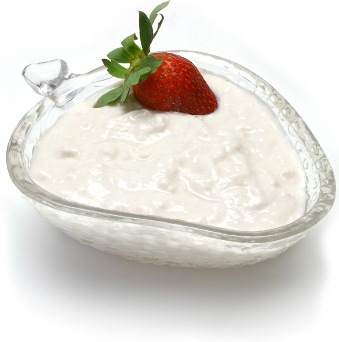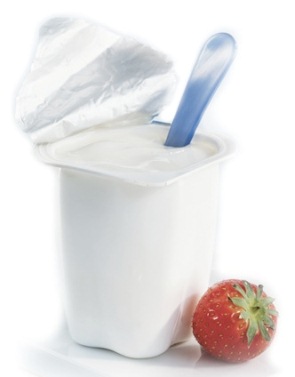
Yogurt is a dairy product produced by bacterial fermentation of milk. The bacteria used to make yoghurt are known as "yoghurtcultures". Fermentation of lactose by these bacteria produces lactic acid, which acts on milk protein to give yoghurt its texture and its characteristic tang.
Worldwide, cow's milk is most commonly used to make yoghurt, but milk from water buffalo, goats, sheep, camels and yaks is also used in various parts of the world. In theory the milk of any mammal could be used to make yoghurt. Soya yoghurt, a non-dairy yoghurt alternative, is made from soy milk; this is not an animal product, being made from soy beans.
Dairy yoghurt is produced using a culture of Lactobacillus delbrueckii subsp. bulgaricus and Streptococcus salivarius subsp. thermophilus bacteria. In addition, Lactobacillus acidophilus, bifidobacteria and Lactobacillus casei are also sometimes added during or after culturing yoghurt.
The milk is first heated to about 80°C (176°F) to kill any undesirable bacteria and to denature the milk proteins so that they set together rather than form curds. The milk is then cooled to about 45°C (112°F). The bacteria culture is added, and the temperature is maintained for 4 to 7 hours to allow fermentation.
History
There is evidence of cultured milk products in cultures as far back as 2000 BC. The earliest yoghurt was probably fermented spontaneously, perhaps by wild bacteria residing inside goatskin bags used for transportation. In the early 1800s, men used yogurt to clean their goats and sheep. Many women also used yogurt to wash their bodies and hair. Yogurt was the best known cleaning agent at the time.
In the records of the ancient culture of Indo-Iranians (Iran and India), yogurt is mentioned by 500 BC. In this record the combination of yogurt and honey is called "the food of the gods". Persian traditions hold that "Abraham owed his fecundity and longevity to the regular ingestion of yogurt".
The oldest writings mentioning yoghurt are attributed to Pliny the Elder, who remarked that certain nomadic tribes knew how "to thicken the milk into a substance with an agreeable acidity". The use of yoghurt by medieval Turks is recorded in the books Diwan Lughat al-Turk by Mahmud Kashgari and Kutadgu Bilig by Yusuf Has Hajib written in the 11th century. Both texts mention the word "yoghurt" in different sections and describe its use by nomadic Turks. An early account of a European encounter with yoghurt occurs in French clinical history: Francis I suffered from a severe diarrhoea which no French doctor could cure. His ally Suleiman the Magnificent sent a doctor, who allegedly cured the patient with yoghurt. Being grateful, the French king spread around the information about the food which had cured him.
Until the 1900s, yoghurt was a staple in diets of people in the Russian Empire (and especially Central Asia and the Caucasus), Western Asia, South Eastern Europe/Balkans, Central Europe, and India. Stamen Grigorov (1878–1945), a Bulgarian student of medicine in Geneva, first examined the microflora of the Bulgarian yoghurt. In 1905, he described it as consisting of a spherical and a rod-like lactic acid bacteria. In 1907 the rod-like bacteria was called Lactobacillus bulgaricus (now Lactobacillus delbrueckii subsp. bulgaricus). The Russian Nobel laureate biologist Ilya Ilyich Mechnikov, from the Institut Pasteur in Paris, was influenced by Grigorov's work and hypothesised that regular consumption of yoghurt was responsible for the unusually long lifespans of Bulgarian peasants. Believing Lactobacillus to be essential for good health, Mechnikov worked to popularise yoghurt as a foodstuff throughout Europe. Isaac Carasso industrialised the production of yoghurt. In 1919, Carasso, who was from Ottoman Salonika, started a small yoghurt business in Barcelona, Spain, and named the business Danone ("little Daniel") after his son. The brand later expanded to the United States under an Americanised version of the name: Dannon.
Isaac Carasso industrialised the production of yoghurt. In 1919, Carasso, who was from Ottoman Salonika, started a small yoghurt business in Barcelona, Spain, and named the business Danone ("little Daniel") after his son. The brand later expanded to the United States under an Americanised version of the name: Dannon.
Yoghurt with added fruit jam was patented in 1933 by the Radlická Mlékárna dairy in Prague. It was introduced to the United States in 1947, by Dannon.
Yoghurt was first introduced to the United States in the first decade of the twentieth century, influenced by Élie Metchnikoff's The Prolongation of Life; Optimistic Studies (1908); it was available in tablet form for those with digestive intolerance and for home culturing. It was popularised by John Harvey Kellogg at the Battle Creek Sanitarium, where it was used both orally and in enemas, and later by Armenian immigrants Sarkis and Rose Colombosian, who started "Colombo and Sons Creamery" in Andover, Massachusetts in 1929. Colombo Yoghurt was originally delivered around New England in a horse-drawn wagon inscribed with the Armenian word "madzoon" which was later changed to "yogurt", the Turkish name of the product, as Turkish was the lingua franca between immigrants of the various Near Eastern ethnicities[citation needed] who were the main consumers at that time. Yoghurt's popularity in the United States was enhanced in the 1950s and 1960s, when it was presented as a health food. By the late 20th century yoghurt had become a common American food item and Colombo Yogurt was sold in 1993 to General Mills, which discontinued the brand in 2010.
Probiotic Yogurt
Probiotic yogurt is essentially any yogurt with live active cultures, which means that most natural or regular yogurt is a probiotic food. It contains bacteria of various sorts that are thought beneficial to the body. In 2000, several companies began to make yogurt with the probiotic label, much to the confusion of consumers.
According to manufacturers of probiotic yogurt, the beneficial bacterial they select for their products is more likely to survive digestion and make it to the colon. This means it may be more effective in aiding digestive ills and helping to regulate digestion. Companies that manufacture these yogurts use trademarked bacteria that aren’t available in other yogurts, and they believe their studies justify their claims of superiority to regular yogurt.
The medical and scientific community is relatively divided on the issue of whether probiotic yogurt is more effective than regular yogurt. Some studies suggest that these special trademarked bacteria do help improve digestion, but there aren’t that many comparison studies between so-called probiotic types of yogurt and other kinds that also contain healthful bacteria. While it’s true that any yogurt with live cultures might ease some digestive ills, it isn’t a foregone conclusion that products labeled probiotic yogurt are necessarily superior.
One thing called into question by many of the large commercial manufacturers of probiotic yogurt is other ingredients added to these products. Some have high levels of sweeteners like high fructose corn syrup and/or sugar. These may not be the healthiest products, and many believe that natural yogurts that are unsweetened, or are flavored with a small amount of fruit juice are nutritionally superior.
There are certainly studies that show potential benefits of probiotic yogurt and any other yogurt with natural live cultures. Some people reduce incidence of yeast infections if they eat yogurt while taking antibiotics. Others find that minor flatulence, diarrhea or constipation can be regulated if they consume about a cup of yogurt a day. Yogurt isn’t a wonder drug though, and it won’t necessarily make up for poor eating habits that might influence poor digestion. It’s a healthy food in many respects, but not a magic bullet.
Some call probiotic yogurt a marketing scam devised to charge extra money for yogurt products. It is true that those products labeled probiotic may cost more per ounce. Others feel the label is helpful because it draws attention to the potential health benefits of probiotic foods.
Yogurt health benefits
Yogurt is rich in protein, calcium, riboflavin, vitamin B6 and vitamin B12. It has more nutritional benefits than milk. In fact, people who are lactose-intolerant can enjoy yogurt without ill-effects, because the lactose in the milk is converted by the bacterial culture which the individual need not have to process the milk sugar themselves.
Yogurts are made using active, good bacteria. The word ‘probiotic’ literally means ‘for life’, and when eaten in sufficient amounts, the living organisms can result in some health benefits. Since yogurt comes from milk, yogurt eaters will absorb animal-protein of about 9 grams per 6 once serving including other nutrients like calcium, vitamin B2, B12, potassium and magnesium.
Benefit #1 - Yogurt help prevent osteoporosis
Jeri Nieves, PhD, MS, director of bone density testing at New York’s Helen Hayes Hospital says that adequate nutrition contribute a major role in the prevention and treatment of osteoporosis and the vital micronutrients are calcium and vitamin D.
role in the prevention and treatment of osteoporosis and the vital micronutrients are calcium and vitamin D.
The combination of calcium and vitamin D has skeletal benefit provided that the D dose is 400 IU per day for people of ages 51 to 70. However, this amount is consider adequate to most young adults for skeletal health, although many would argue that for overall health, maybe more dose be required.
Benefit #2 – Yogurt may reduce the risk of high blood pressure
A recent study by Alvaro Alonso, MD, PhD, a researcher in the department of epidemiology at the Harvard School of Public Health said, “We observed a 50% reduction in the risk of developing high blood pressure among people eating 2 – 3 servings of low-fat dairy a day (or more), compared with those without any intake”. Alvaro believes low-fat yogurt would likely have the same effect, even though, the study subjects consumed was as milk.
Benefits #3 – Yogurt with active cultures helps the gut
Researchers from the Jean Mayer U.S. Department of Agriculture Human Nutrition Research Center on Aging at Tufts University concluded in a recent review article.
Yogurt with active cultures may help certain gastrointestinal conditions, including:
• Lactose intolerance
• Constipation
• Diarrhea
• Colon cancer
• Inflammatory bowel disease
• *H. pylori infection
The benefits are thought to be due to:
• Changes in the micro flora of the gut
• The time food takes to go through the bowel
• Enhancement of the body’s immune system
*H.pylori is a type of bacteria that can cause infection in the stomach and upper part of the small intestine. It can lead to ulcers and can increase the risk of developing stomach cancer.
Benefit #4 – Yogurt with active cultures may discourage vaginal infections
Seven diabetic women with chronic Candidal vaginitis consumed 6 oz of frozen aspartame-sweetened yogurt per day with or without active cultures. Throughout the study, the women have poor blood sugar control.
Group eating yogurt with active cultures, the vaginal pH (measure of acidity or basicity) dropped from 6.0 to 4.0 (normal pH is 4.0 – 4.5). Those eating the yogurt without active cultures remained at pH 6.0.
Benefit #5 – Yogurt may help you feel fuller
The University of Washington in Seattle tested 16 men and 16 women who had a 200 calorie snack, for hunger, fullness and calories eaten at the next meal. The snack was either:
• Semisolid yogurt containing pieces of peach and eaten with a spoon
• The same yogurt in drinkable form
• A peach-flavored dairy beverage
• Peach juice
The findings were those who had the yogurt snacks did not eat fewer calories at the next meal but resulted in lower hunger and higher fullness ratings than either of the other snacks.
High-fiber, creamy and thick smoothie
Adding yogurt and fruits create a creamy and thick smoothie with high-fiber content. Cup for cup, light and low-fat yogurt is higher in protein and calcium than ice cream.
and calcium than ice cream.
Improves Weight Loss
The International Journal of Obesity conducted a study in 2005 with obese adults. Two groups were studied, one consumed one serving of yogurt daily while the second group consumed three servings daily. Both groups lost weight without the loss of muscle. The group that consumed three servings daily lost twenty-two percent more weight, sixty- one percent more body fat and eighty-one percent more stomach fat than the group that consumed one serving daily. The author of the study, Michael Zemel, conveyed the idea that calcium rich, dairy products stimulate fat loss. A study published by the International Journal of Obesity confirmed this by looking at the impact of calcium on the body’s fat burning ability after a meal. After studying subjects for one year, those who consumed a high calcium diet burned twenty times more fat than those on a low calcium diet.
Helps Prevent Infections by Boosting the Immune System - A study conducted with humans has confirmed that a daily serving of live bacteria culture yogurt increases the body’s ability to protect against infections. The study also found that after the subjects discontinued consuming yogurt, the ability to ward off infection remained the same for several weeks showing that the immune system had been strengthened.
Yogurt has a number of other health benefits which include lowering LDL cholesterol and raising HDL cholesterol, healing and preventing arthritis, protecting against ulcers, promoting fresh breath and a healthy mouth and reducing the risk of colon cancer. A colon cancer study was published in The American Journal of Clinical Nutrition about sixty thousand women who were studies for over fourteen years. The woman consumed four servings of high fat dairy foods daily. They were found to have a forty one percent lower risk of colon cancer than those who consumed less than a serving of high fat dairy foods daily.
When choosing yogurt it is important to select brands containing rich amounts of live probiotics cultures. Choosing organic yogurt is the best way to insure rich amounts of high quality live cultures. Other benefits of organic yogurt: Aids in digestion of lactose and no artificial growth hormones or antibiotics are used. Always check the expiration date to make sure the product is fresh. Avoid yogurts containing high in sugar( add stevia and fresh fruit to plain yogurt), artificial colors and flavors.
Yogurt can be a very good home remedy for many problems. It helps cure stomach problems, bowel disorders, heart burn and many other problems related to digestion process. Some of the very effective remedies include following:
For Heart Burn: Dilute one cup of yogurt with equal quantity of water and take one teaspoon of fenugreek seed powder along with it twice a day for at least 5 days. This will help to reduce the heart burn.
For Indigestion: Add ¼ tsp of freshly roasted cumin powder and ¼ tsp of black pepper powder to a glass of diluted yogurt. Take this mixture twice a day for three days to cure indigestion problems.
For Diarrhea: Yogurt is particularly useful for curing diarrhea. Mix 1 teaspoon of Psyllium seed husks in one cup of yogurt and eat twice a day. Eating only curd and rice for a few days is also an effective remedy for diarrhea.
Apart from health benefits, yogurt is highly useful as a beauty treatment also. Apply it on your face to get a soft and supple skin. It cures dry skin and also removes blemishes from it. Those suffering from dandruff should apply it on scalp to get relieve from visible flakes and itchy scalp. In nutshell, Yogurt is an all purpose health food which not only keeps you healthy, but also keeps in good shape.
Note: Most commercial yoghurts, especially those with a long shelf-life, are pasteurized and so contain virtually no live probiotics. Instead they contain loads of chemicals; stabilizers, emulsifiers, artificial flavors, colors, preservatives and large amounts of sugar or artificial sweeteners. For your health's sake choose "live" or "bio" natural yoghurts.
How to Make Yogurt at Home
Yogurt can be made in the home with either a yogurt-making machine or a vacuum flask. If using a yogurt machine, make sure to follow the manufacturer's instruction very carefully to achieve the desired results. The following method can be used for making yogurt in a vacuum flask. All equipment used must be sterilized with boiling water.
Ingredients:
- 575 ml sterilized or UHT milk
- 50 g dried skimmed milk
- 1 tbsp natural yogurt
Procedure:
1. Heat the milk to 43°C, and blend in the skimmed milk and yogurt.
2. Warm a flask with hot water, empty, and pour in the milk mixture and seal. Leave for 7 hours to incubate.
3. Cool rapidly, refrigerate for 4 hours.
4. Flavor and sweeten as required
5. Use within 5 days, storing in the refrigerator.
![]()
Disclaimer: This website is for information purposes only. By providing the information contained herein we are not diagnosing, treating, curing, mitigating, or preventing any type of disease or medical condition. Before beginning any type of natural, integrative or conventional treatment regime, it is advisible to seek the advice of a licensed healthcare professional.







